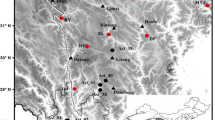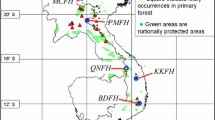Abstract
Two millennia-length juniper ring width chronologies, processed to preserve multi-centennial growth trends, are presented for the Alai Range of the western Tien Shan in Kirghizia. The chronologies average the information from seven near-timberline sampling sites, and likely reflect summer temperature variation. For comparison, chronologies are also built using standard dendrochronological techniques. We briefly discuss some qualities of these “inter-decadal” records, and show the low frequency components removed by the standardization process include a long-term negative trend in the first half of the last millennium and a long-term positive trend since about AD 1800. The multi-centennial scale Alai Range chronologies, where these trends are retained, are both systematically biased (but in an opposite sense) in their low frequency domains. Nevertheless, they represent the best constraints and estimates of long-term summer temperature variation, and reflect the Medieval Warm Period, the Little Ice Age, and a period of warming since about the middle of the nineteenth century.




Similar content being viewed by others
References
Becker M, Bert GD, Bouchon J, Dupouey JL, Picard JF, Ulrich E (1995) Long-term changes in forest productivity in northeastern France: the dendroecological approach. In: Landmann G, Bonneau M (eds) Forest decline and atmospheric deposition effects in the French mountains, Springer, Berlin, pp 143–156
Borgaonkar HP, Pant GB, Rupa Kumar K (1999) Tree-ring chronologies from Western Himalaya and their dendroclimatic potential. IAWA J 20: 295–309
Bräker OU (1981) Der Alterstrend bei Jahrringdichten und Jahrringbreiten von Nadelhölzern und sein Ausgleich. Mitt der Forstl Bundesversuchsanst Wien 142: 75–102
Bräuning A (1994) Dendrochronology for the last 1400 years in Eastern Tibet. GeoJournal 34: 75–95
Bräuning A (1999) Zur Dendroklimatologie Hochtibets während des letzten Jahrtausends. Dissertationes Botanicae 312
Briffa KR, Osborn TJ (2002) Blowing hot and cold. Science 295: 2227–2228
Briffa KR, Jones PD, Bartholin TS, Eckstein D, Schweingruber FH, Karlén W, Zetterberg P, Eronen M (1992) Fennoscandian summers from AD 500: temperature changes on short and long time scales. Clim Dyn 7: 111–119
Briffa KR, Jones PD, Schweingruber FH, Shiyatov S, Cook ER (1995) Unusual twentieth-century summer warmth in a 1000-year temperature record from Siberia. Nature 376: 156–159
Briffa KR, Jones PD, Schweingruber FH, Karlén W, Shiyatov S (1996) Tree-ring variables as proxy-climate indicators: problems with low-frequency signals. In: Jones PD, Bradley RS, Jouzel J (eds) Climatic variations and forcing mechanisms of the last 2000 years. Springer, Berlin, pp 9–41
Briffa KR, Osborn TJ, Schweingruber FH, Harris IC, Jones PD, Shiyatov SG, Vaganov EA (2001) Low-frequency temperature variations from a northern tree ring density network. J Geophys Res 106: 2929–2941
Cook ER (1985) A time series analysis approach to tree-ring standardization. New York, Lamont-Doherty Geological Observatory, pp 171
Cook ER, Peters K (1981) The smoothing spline: a new approach to standardizing forest interior tree-ring width series for dendroclimatic studies. Tree-Ring Bulle 41: 45–53
Cook ER, Kairiukstis LA (1990) Methods of dendrochronology: applications in the environmental science. Kluwer, Dordrecht, pp 394
Cook ER, Peters K (1997) Calculating unbiased tree-ring indices for the study of climatic and environmental change. The Holocene 7: 361–370
Cook ER, Briffa KR, Meko DM, Graybill DA, Funkhouser G (1995) The ‘segment length curse’ in long tree-ring chronology development for palaeoclimatic studies. The Holocene 5: 229–237
Cook ER, Buckley BM, D’Arrigo RD, Peterson MJ (2000) Warm-season temperatures since 1600 BC reconstructed from Tasmanian tree rings and their relationship to large-scale sea surface temperature anomalies. Clim Dyn 16: 79–91
Cook ER, Krusic PJ, Jones PD (2003) Dendroclimatic signals in long tree-ring chronologies from the Himalayas of Nepal. Int J Climatol 23: 707–732
D’Arrigo R, Jacoby G, Frank D, Pederson N, Cook E, Buckley B, Nachin B, Mijiddorj R, Dugarjav C (2001) 1738 years of Mongolian temperature variability inferred from a tree-ring width chronology of Siberian pine. Geophys Res Lett 28: 543–546
Esper J (2000a) Long term tree-ring variations in junipers at the upper timberline in the Karakorum (Pakistan). The Holocene 10: 253–260
Esper J (2000b) Paläoklimatische Untersuchungen an Jahrringen im Karakorum und Tien Shan Gebirge (Zentralasien). Bonner Geographische Abhandlungen 103
Esper J, Bosshard A, Schweingruber FH, Winiger M (1995) Tree-rings from the upper timberline in the Karakorum as climatic indicators for the last 1000 years. Dendrochronologia 13: 79–88
Esper J, Neuwirth B, Treydte K (2001) A new parameter to evaluate temporal signal strength of tree ring chronologies. Dendrochronologia 19: 93–102
Esper J, Cook ER, Peters K, Schweingruber FH (2002a) Detecting low frequency tree-ring trends by the RCS method. Tree-Ring Research, (in press)
Esper J, Cook ER, Schweingruber FH (2002b) Low-frequency signals in long tree-ring chronologies and the reconstruction of past temperature variability. Science 295: 2250–2253
Esper J, Schweingruber FH, Winiger M (2002c) 1300 years of climate history for Western Central Asia inferred from tree-rings. The Holocene 12: 267–277
Esper J, Treydte K, Gärtner H, Neuwirth B (2002d) A tree ring reconstruction of climatic extreme years since AD 1427 for Western Central Asia. Palaeobotanist 50: 141–152
Ferguson CW (1968) Bristlecone pine: science and esthetics. Science 159: 839–846
Fritts HC (1976) Tree rings and climate. Academic Press, London, pp 567
Graybill DA, Shiyatov SG, Burmistrov VF (1992) Recent dendrochronological investigations in Kirghizia, USSR. Lundqua Rep 34: 123–127
Hughes MK (1992) Dendroclimatic evidence from the Western Himalaya. In: Bradley RS, Jones PD (eds) Climate since AD 1500. Routledge, London, pp 415–431
IPCC working group I (2001) Summary for policymakers of the third assessment report, (www.usgcrp.gov/ipcc/wg1spm.pdf)
Jacoby GC, D’Arrigo RD, Davaajamts T (1996) Mongolian tree rings and 20th-century warming. Science 273: 771–773
Jones PD, New M, Parker DE, Martin S, Rigor IG (1999) Surface air temperature and its variations over the last 150 years. Rev Geophys 37: 173–199
Kelly PE, Cook ER, Larson DW (1992) Constrained growth, cambial mortality, and dendrochronology of ancient Thuja occidentalis on cliffs of the Niagara Escarpment – An eastern version of Bristlecone pine? Int J Plant Sci 153: 117–127
LaMarche VC (1974) Paleoclimatic inferences from long tree-ring records. Science 183: 1043–1048
Mitchell VL (1967) An investigation of certain aspects of tree growth rates in relation to climate in the central Canadian boreal forest. Techn Rep 33. University of Wisconsin, Department of Meteorology, Wisconsin, pp 62
Osborn TJ, Briffa KR, Jones PD (1997) Adjusting variance for sample-size in tree-ring chronologies and other regional-mean time-series. Dendrochronologia 15: 89–99
Schweingruber FH (1996) Tree rings and environment – dendroecology. Haupt, Bern, pp 609
Wigley TML, Briffa KR, Jones PD (1984) On the average of correlated time series, with applications in dendroclimatology and hydrometeorology. J Clim Appl Meteorol 23: 201–213
Wright RD, Mooney HA (1965) Substrate-oriented distribution of Bristlecone pine in the White Mountains of California. The American Midland Naturalist 73: 257–284
Yadav RR, Park WK, Bhattacharyya A (1997) Dendroclimatic reconstruction of April–May temperature fluctuations in the western Himalaya of India since AD 1698. Quat Res 48: 187–191
Acknowledgements
We thank David Frank and two anonymous reviewers for valuable comments on earlier drafts of this study. The work was Supported by the Swiss National Science Foundation, Grant 2100-066628 (J.E.).
Author information
Authors and Affiliations
Corresponding author
Rights and permissions
About this article
Cite this article
Esper, J., Shiyatov, S.G., Mazepa, V.S. et al. Temperature-sensitive Tien Shan tree ring chronologies show multi-centennial growth trends. Climate Dynamics 21, 699–706 (2003). https://doi.org/10.1007/s00382-003-0356-y
Received:
Accepted:
Published:
Issue Date:
DOI: https://doi.org/10.1007/s00382-003-0356-y




